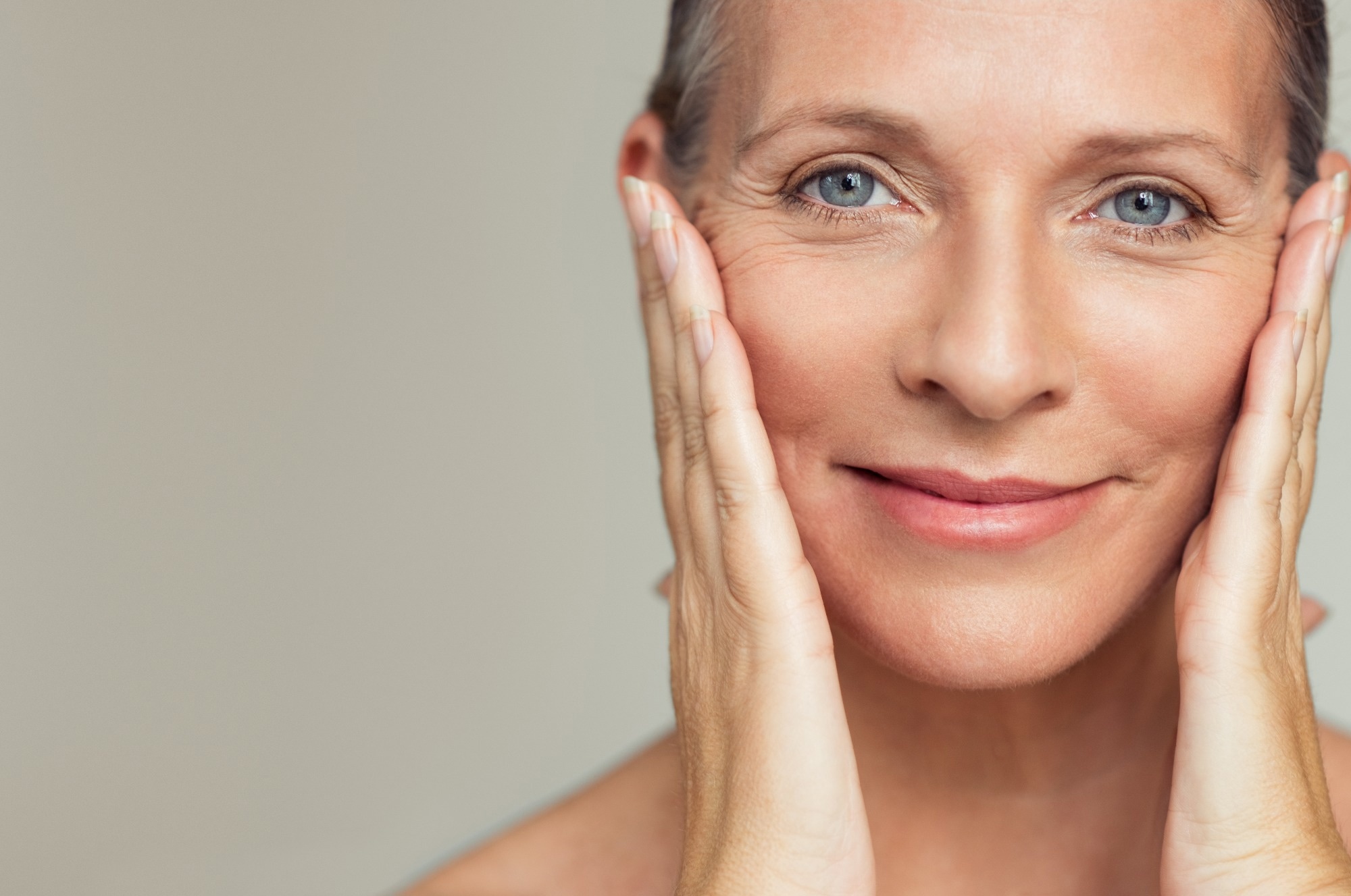The fragmentation of type I collagen has been seen to impair the integrity of the dermal extracellular matrix (ECM). This results in lower type I procollagen synthesis and contracted or collapsed fibroblasts.
A recent Experimental Dermatology study assessed how these deleterious changes could be reversed by injecting cross-linked hyaluronic acid (CL-HA).
 Study: Implications for cumulative and prolonged clinical improvement induced by cross-linked hyaluronic acid: An in vivo biochemical/microscopic study in humans. Image Credit: Ground Picture/Shutterstock.com
Study: Implications for cumulative and prolonged clinical improvement induced by cross-linked hyaluronic acid: An in vivo biochemical/microscopic study in humans. Image Credit: Ground Picture/Shutterstock.com
Background
Photoaging of the human skin is caused by chronic exposure to ultraviolet irradiation. This is characterized by fragility, wrinkles, and low elasticity, mainly caused by dermal deleterious molecular alterations.
ECM in the dermis comprises 80%–90% type I collagen, which supports and strengthens the human skin. Dermal fibroblasts produce type I collagen, which forms an interwoven mesh in the ECM. The interactions between the ECM and dermal fibroblasts determine cell functions.
As the skin photoages, fragmentation of type I collagen occurs due to a greater expression and enzymatic activity of metalloproteinases (MMPs). This weakens the collagenous scaffolding, making it difficult for fibroblasts to bind.
Prior research has shown that cross-linked hyaluronic acid (CL-HA) injection can reverse these changes.
About this study
To delve further into the biochemical mechanism of CL-HA action, CL-HA and vehicle (saline) were injected into the photoaged skin of human subjects aged 60 years and above.
To assess whether fibroblast activation led to the deposition/accumulation of dermal collagen, biochemical/microscopic analyses were performed.
Study findings
From 1 week to 6–9 months post-injection, fibroblasts demonstrated activation. Multiphoton microscopy at 1-week post-injection showed stretching of fibroblasts. This indicated greater dermal mechanical support.
A second harmonic generation microscopy analysis at four weeks post-injection showed densely packed thick collagen bundles around pools of injected CL-HA.
At 12 months post-injection, it was noted that thick collagen bundles accumulated, and a significant amount of CL-HA was also present.
Therefore, it was concluded that CL-HA enhanced mechanical support rapidly and durably by occupying space in the dermal ECM.
CL-HA prompted fibroblast activation and elongation, resulting in densely packed and thick type I collagen bundles at four weeks post-injection and continuing till at least week 52.
Important components of the TGF-β pathway were also stimulated post-injection, and this pathway is crucial for the synthesis of type 1 procollagen by fibroblasts.
The elements of the TGF-β pathway are decreased in photoaged skin, which reduces the synthesis of type 1 procollagen. The findings of this study suggest that the activation of the TGF-β pathway could regulate the response of fibroblasts to higher dermal mechanical support.
It was noted that post-injection with CL-HA, procollagen N- and C- proteinase enzymes increased rapidly. These enzymes aid in the assembly of intact type 1 collagen.
Immediately after the injection, clinical improvement of the skin could be due to the filler, which occupies space in the dermal ECM and provides mechanical support.
Considering the fact that collagen bundles accumulated till at least week 52, it could be the case that following the CL-HA injection, the type 1 procollagen is converted to
durable and stable dermal type 1 collagen. Furthermore, the presence of the injected filler after 12 months suggests the are long-lasting clinical benefits of CL-HA.
Future research should investigate which properties of HA contribute to the clinical benefits of CL-HA.
The findings documented here have other clinical implications as well. Intact and mature type 1 dermal collagen has an extremely stable half-life of approximately 15 years.
This suggests that collagen bundles should continue accumulating for years after a single CL-HA injection, reducing the need for subsequent treatment following each re-injection.
The observations made here also support the theory that the integrity of the dermal ECM heavily determines functional decline and fibroblast collapse in photoaging.
Interestingly, these functional and cellular changes are reversible by stimulating fibroblasts in photoaged skin by augmenting dermal mechanical support.
Conclusions
In sum, the findings in this study suggest that interventions that provide more mechanical support to photoaged can activate fibroblasts durably and rapidly, thereby leading to collagen deposition.
More specifically, a CL-HA injection stimulated synthetic activation and fibroblast stretching durably (for 6-9 months) and rapidly (within one week).
The result was the accumulation of densely packed and thick type 1 collagen bundles. This accumulation started as early as four weeks and lasted at least a year post-injection.
A sustained clinical improvement is obtained by the accumulation of dermal collagen, which can last for years. The findings of this study pave the way for future research on the frequency and timing of repeat CL-HA injections.
Journal reference:
-
Wang, F., Do, T. T., Smith, N., Orringer, J. S., Kang, S., Voorhees, J. J., and Fisher, G. J. (2024) Implications for cumulative and prolonged clinical improvement induced by cross-linked hyaluronic acid: An in vivo biochemical/microscopic study in humans. Experimental Dermatology. 33(1), e14998. doi: https://doi.org/10.1111/exd.14998. https://onlinelibrary.wiley.com/doi/10.1111/exd.14998.